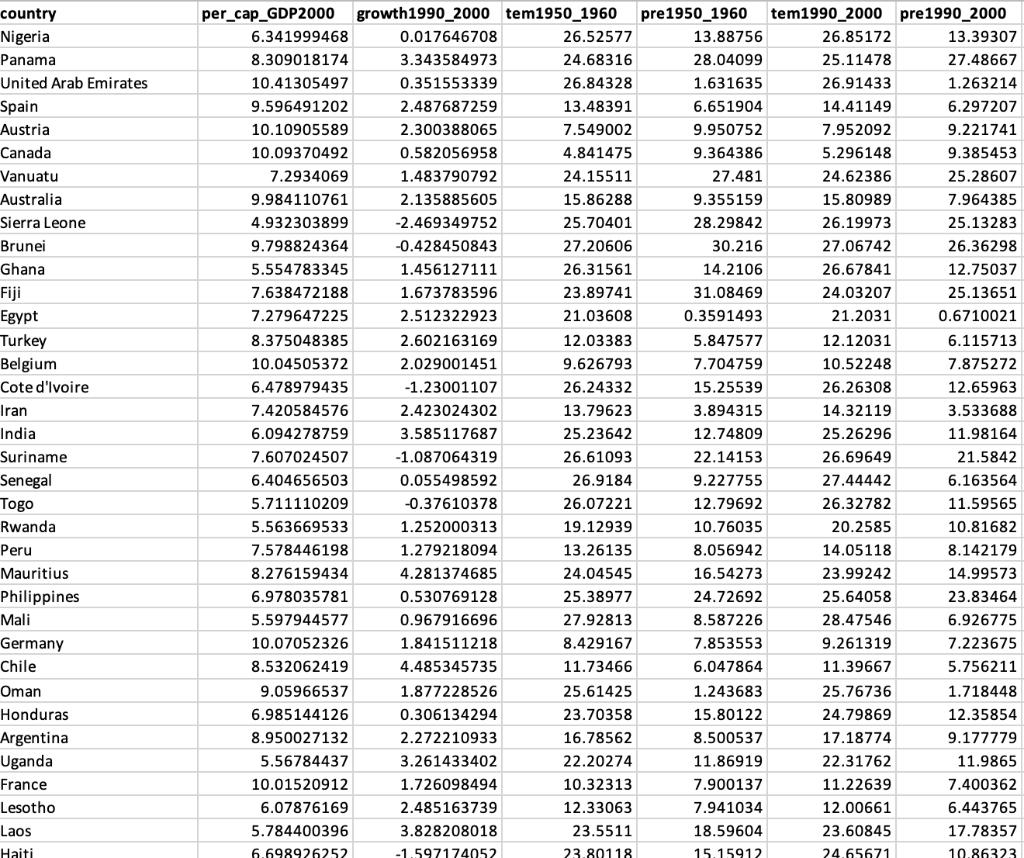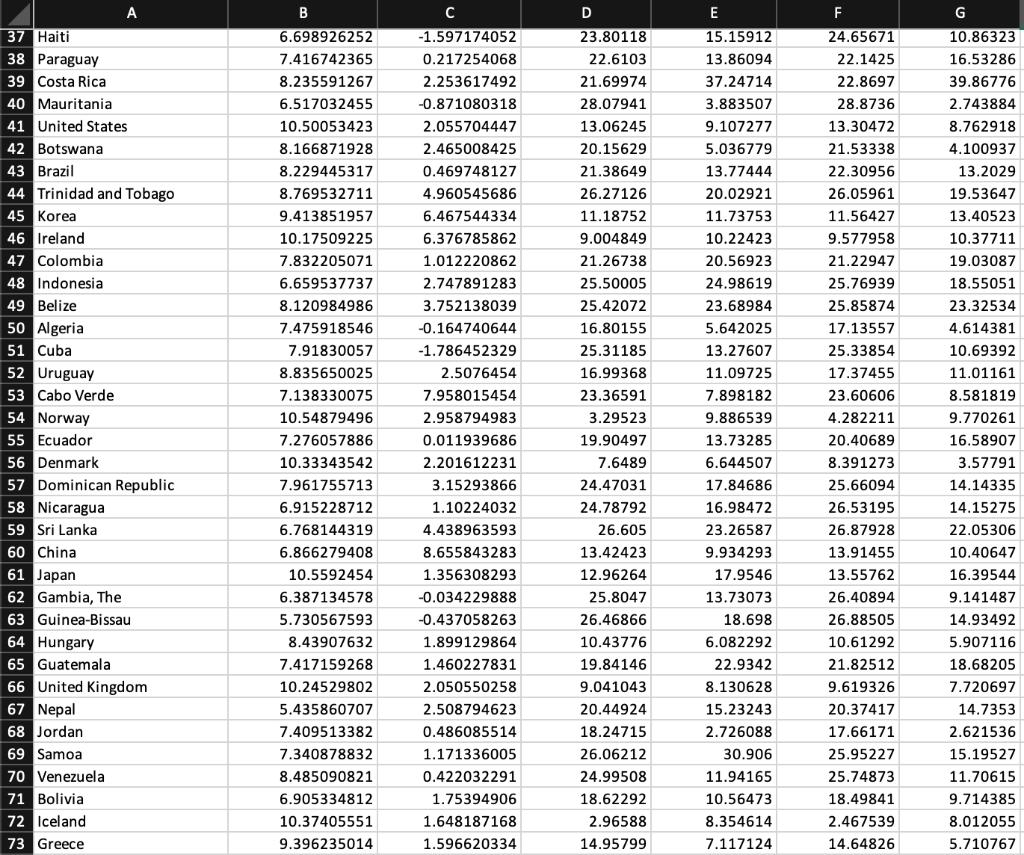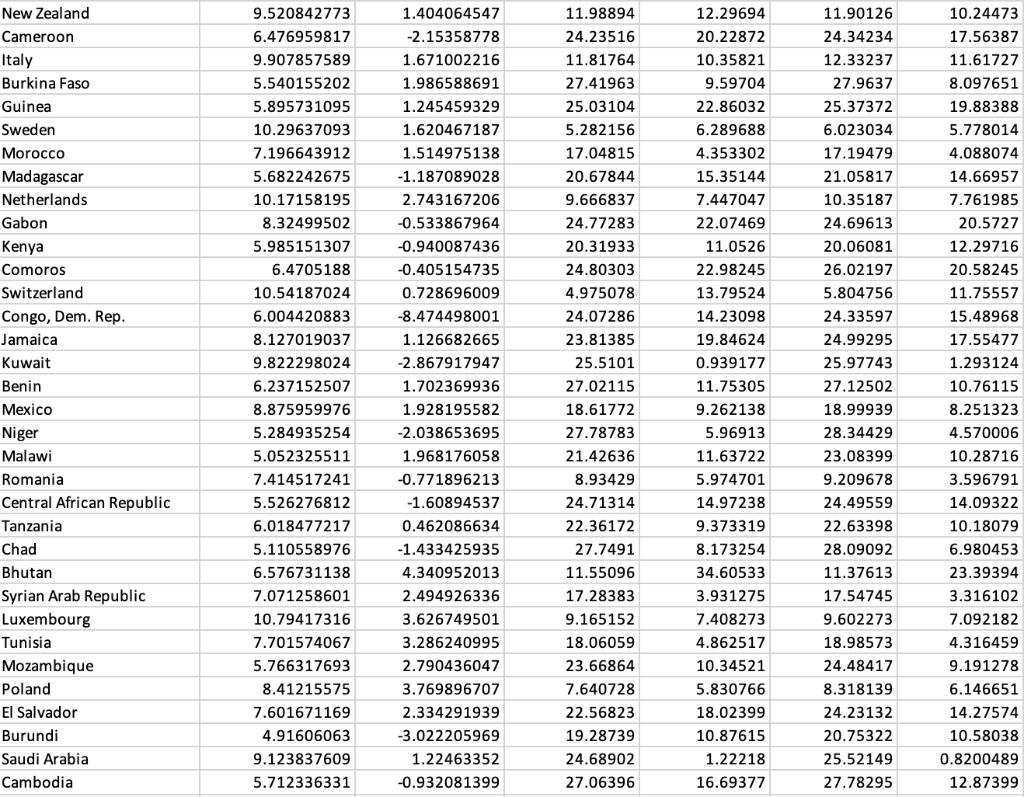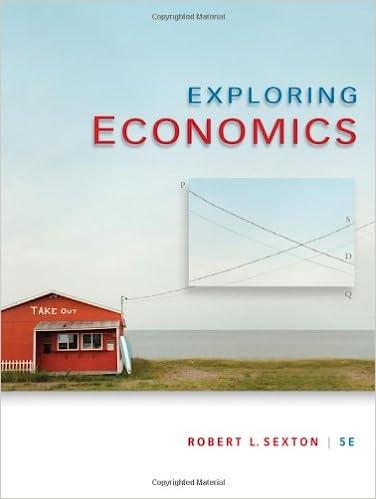Question
1. Has the global been becoming warmer and drier over 1950-2000? Draw evidence on the descriptive statistics of relevant variables in the dataset. 2. Do
1. Has the global been becoming warmer and drier over 1950-2000? Draw evidence on the descriptive statistics of relevant variables in the dataset.
2. Do hot and dry countries tend to be poor (with lower per capita GDP)? Use appropriate graphs to interpret the relationship between relevant variables. You only need to present two relationships. Carefully interpret and explain.
3. Calculate the sample covariance and correlation for the two relationships in question 2 above using Data Analysis Tool Pack or Excel statistical functions. In addition, you are required to calculate the sample covariance and correlation using a second method (using basic Excel formulae without Data Analysis Tool Pack). The calculations by the second method should be carefully laid out in Excel and should NOT use any hard-wired Excel statistical functions e.g. COVARIANCE.S, CORREL, et al. You can use the Excel sort command, the sum command, and any other non-statistical excel commands. Carefully interpret your results.
4. Use simple regression to explore the relationship between (i) annual growth of per capita GDP over 1990-2000 (Y) and mean temperature over 1990-2000 (X); (ii) annual growth of per capita GDP over 1990-2000 (Y) and mean precipitation over 1990-2000 (X), respectively. You may use Data Analysis Tool Pack for this. Based on the excel regression output, first write down the estimated regression equations, then carry out any relevant two-tailed hypothesis tests using the critical value approach at the 5% significance level. Carefully interpret your hypothesis test results.
5. Now use multiple regression to explore the relationship of annual growth of per capita GDP over 1990-2000 (Y) with, mean temperature over 1990-2000 (X1), and mean precipitation over 1990-2000 (X2). You may use Data Analysis Tool Pack for this. Based on the excel regression output, first write down the estimated regression equation, then interpret the estimated coefficients on the mean temperature over 1990-2000 (X1), and mean precipitation over 1990-2000 (X2). Carry out any relevant two-tailed hypothesis tests using the p-value approach at the 5% significance level, and an overall significance test using the p-value approach. Carefully interpret your hypothesis test results.
6. Write down a paragraph or two to illustrate: a) why the hypothesis test is required in the above regression analysis (either simple or multiple); b) the underlying mechanism/intuition of a two-tailed hypothesis test in the context of regression analysis. Aid your illustration with diagrams that you think appropriate.
7. Carefully interpret the adjusted R-squared in the multiple regression analysis.
8. If you could request additional data to study the factors that influence the annual growth of per capita GDP, what extra variables would you request? Illustrate two such variables. Carefully explain why you choose these two variables (by drawing evidence from the literature such as journal articles, newspapers, et al), types of your proposed variables (e.g. numerical or categorical), and how each of your proposed variables will be measured in the regression model.


country per_cap_GDP2000 growth1990 2000 tem1950_1960 pre1950 1960 tem1990 2000 pre1990 2000 Nigeria 6.341999468 0.017646708 26.52577 13.88756 26.85172 13.39307 Panama 8.309018174 3.343584973 24.68316 28.04099 25.11478 27.48667 United Arab Emirates 10.41305497 0.351553339 26.84328 1.631635 26.91433 1.263214 Spain Austria 9.596491202 2.487687259 13.48391 6.651904 14.41149 6.297207 10.10905589 2.300388065 7.549002 9.950752 7.952092 9.221741 Canada 10.09370492 0.582056958 4.841475 9.364386 5.296148 9.385453 Vanuatu Australia Sierra Leone 7.2934069 1.483790792 24.15511 27.481 24.62386 25.28607 9.984110761 2.135885605 15.86288 9.355159 15.80989 7.964385 4.932303899 -2.469349752 25.70401 28.29842 26.19973 25.13283 Brunei 9.798824364 -0.428450843 27.20606 30.216 27.06742 26.36298 Ghana 5.554783345 1.456127111 26.31561 14.2106 26.67841 12.75037 Fiji 7.638472188 1.673783596 23.89741 31.08469 24.03207 25.13651 Egypt 7.279647225 2.512322923 21.03608 0.3591493 21.2031 0.6710021 Turkey Belgium 8.375048385 2.602163169 12.03383 5.847577 12.12031 6.115713 10.04505372 2.029001451 9.626793 7.704759 10.52248 7.875272 Cote d'Ivoire 6.478979435 -1.23001107 26.24332 15.25539 26.26308 12.65963 Iran 7.420584576 2.423024302 13.79623 3.894315 14.32119 3.533688 India 6.094278759 3.585117687 25.23642 12.74809 25.26296 11.98164 Suriname 7.607024507 -1.087064319 26.61093 22.14153 26.69649 21.5842 Senegal Togo 6.404656503 0.055498592 26.9184 9.227755 27.44442 6.163564 5.711110209 -0.37610378 26.07221 12.79692 26.32782 11.59565 Rwanda 5.563669533 1.252000313 19.12939 10.76035 20.2585 10.81682 Peru 7.578446198 1.279218094 13.26135 8.056942 14.05118 8.142179 Mauritius 8.276159434 4.281374685 24.04545 16.54273 23.99242 14.99573 Philippines 6.978035781 0.530769128 25.38977 24.72692 25.64058 23.83464 Mali 5.597944577 0.967916696 27.92813 8.587226 28.47546 6.926775 Germany 10.07052326 1.841511218 8.429167 7.853553 9.261319 7.223675 Chile 8.532062419 4.485345735 11.73466 6.047864 11.39667 5.756211 Oman 9.05966537 1.877228526 25.61425 1.243683 25.76736 1.718448 Honduras 6.985144126 0.306134294 23.70358 15.80122 24.79869 12.35854 Argentina 8.950027132 2.272210933 16.78562 8.500537 17.18774 9.177779 Uganda 5.56784437 3.261433402 22.20274 11.86919 22.31762 11.9865 France 10.01520912 1.726098494 10.32313 7.900137 11.22639 7.400362 Lesotho 6.07876169 2.485163739 12.33063 7.941034 12.00661 6.443765 Laos 5.784400396 3.828208018 23.5511 18.59604 23.60845 17.78357 Haiti 6.698926252 -1.597174052 23.80118 15.15912 24.65671 10.86323
Step by Step Solution
3.45 Rating (152 Votes )
There are 3 Steps involved in it
Step: 1
1 The mean temperature between the period 1950 to 1960 and the period 1990 to 2000 has risen from 1947 to 1987 For the same period the mean precipitation has decreased from 1353 to 1222 2 The chart of ...
Get Instant Access to Expert-Tailored Solutions
See step-by-step solutions with expert insights and AI powered tools for academic success
Step: 2

Step: 3

Ace Your Homework with AI
Get the answers you need in no time with our AI-driven, step-by-step assistance
Get Started


